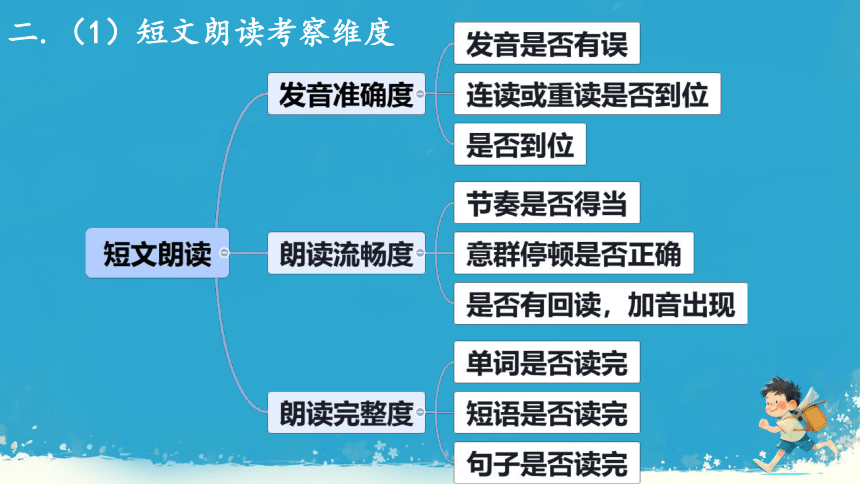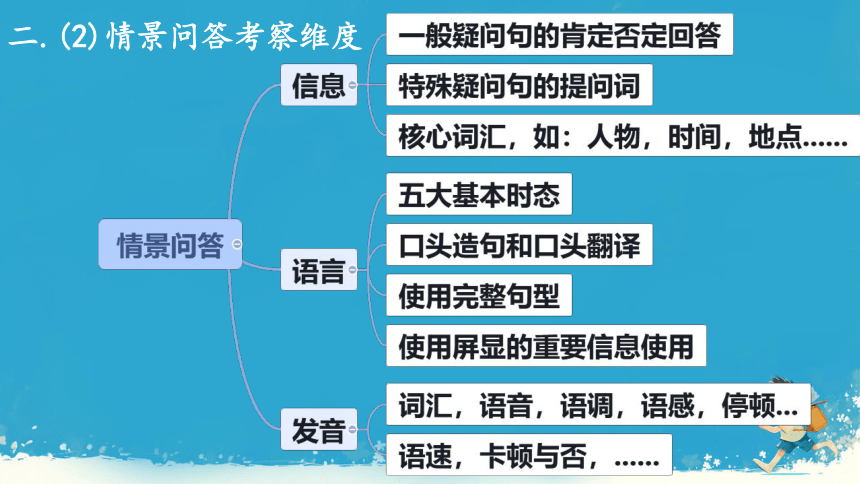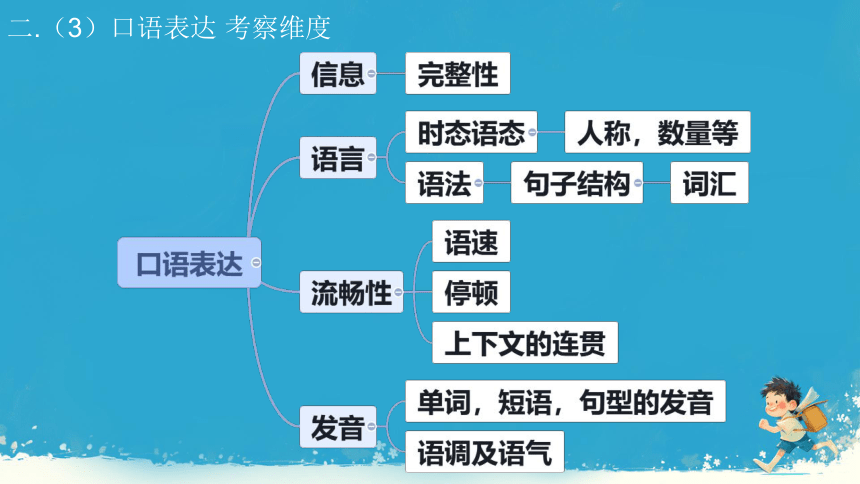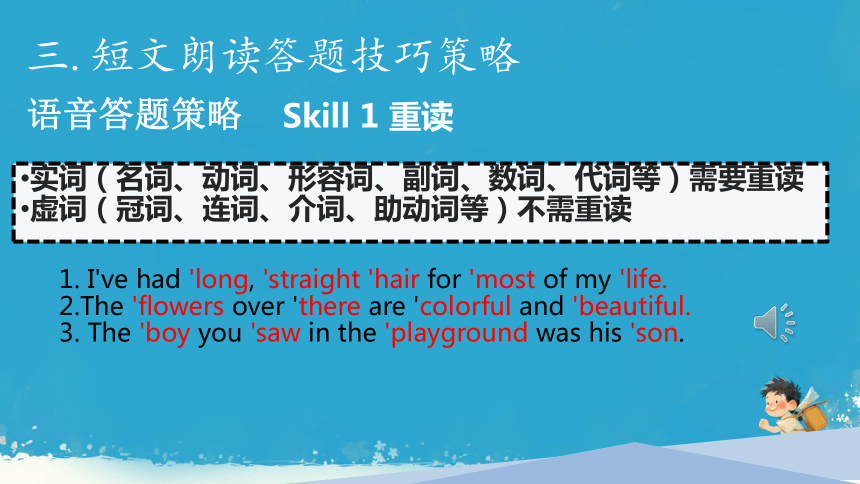人机对话听说考试答题技巧策略课件(共26张PPT,内嵌音频)2024-2025学年人教版(Go for it)英语九年级全册
文档属性
| 名称 | 人机对话听说考试答题技巧策略课件(共26张PPT,内嵌音频)2024-2025学年人教版(Go for it)英语九年级全册 |  | |
| 格式 | pptx | ||
| 文件大小 | 19.6MB | ||
| 资源类型 | 教案 | ||
| 版本资源 | 人教新目标(Go for it)版 | ||
| 科目 | 英语 | ||
| 更新时间 | 2024-11-16 12:28:45 | ||
图片预览









文档简介
(共26张PPT)
人机对话考试考场答题技巧策略
目录
一
人机对话题型答题要求
二
人机对话题型考查维度
三
人机对话题型答题技巧
一、人机对话题型答题要求
在回答每小题前,你将在屏幕上看到一个问题并听到一段对话,对话读两遍。你有10秒钟的时间准备,在听到“嘟”的一声提示音后,回答该问题。在15秒钟内完成。
2.情景对话:
你将在屏幕上看到一篇短文并有2分钟的时间准备,在听到“嘟”的一声提示音后,朗读该短文。在2分钟内完成。
1.短文朗读:
你将听到一篇短文并在屏幕上看到该短文的中文要点和英文关键词,短文读两遍。你有2分钟的准备时间,在听到“嘟”的一声提示音后,根据中文要点和你听到的内容,进行复述(须包含所有要点)。在2分钟内完成。
3.口语表达:
二.(1)短文朗读考察维度
二.(2)情景问答考察维度
二.(3)口语表达 考察维度
1. I've had 'long, 'straight 'hair for 'most of my 'life.
2.The 'flowers over 'there are 'colorful and 'beautiful.
3. The 'boy you 'saw in the 'playground was his 'son.
实词(名词、动词、形容词、副词、数词、代词等)需要重读
虚词(冠词、连词、介词、助动词等)不需重读
三.短文朗读答题技巧策略
Skill 1 重读
语音答题策略
Skill 2 连读
辅音结尾
+
元音开头
连读
r / re + 元音开头 连读
1. Can you play games with us
2. I need a pair of sports shoes for school.
3. People are afraid of me because I can make them very sick.
语音答题策略
Skill 3 停顿
停顿不是随意的,只能在意群之间进行。
意群主要有三类:短语、短句,简单句、从句和长名词。
Some people/ do not/ respect nature. / Then, /I can jump/ from animals to humans. / People are afraid of me/ because I can make them very sick. / I can jump/ from one person to another, / making many people sick.
语音答题策略
1)降调:一般用于陈述句、特殊疑问句、祈使句、感叹句中。如:
I will go to Hong Kong tomorrow↘.
What did you do in the summer holiday↘
What a nice day today↘!
2)升调:一般用于一般疑问句中。如:Is the boy your brother↗
3)升降调:一般用于选择疑问句、列举并列成分、从句在前主句在后的复合句中。如:Which do you prefer, the banana↗or the apple↘
4)降升调:一般用于反意疑问句中。
如:He likes swimming↘, doesn’t he↗
短文朗读语调答题技巧策略
朗读基本知识(七下)
朗读基本知识
1. 句子重音( Sentence Stress)
英语中每个独立的词都有词的重音,但在连贯言语中有些词就失去重音了,这是因为并非所有的词在语句中都有同等的重要性。一般来说,实词如名词、动词、形容词和副词等重读,而虚词如冠词、连词、介词、人称代词、助动词、情态动词肯定式一般不重读。例如:
1) A: What' time do you' usually' get' up B: At' eight' thirty in the' morning.
2) A:' How do you' get to' school B:I' ride my' bike. It's' good' exercise.
3) A:What are you' doing B:I'm ' playing ' basketball with some' friends at the ' park.
A:'Sounds like you' re ' having a ' good' time.
2. 不完全爆破( Incomplete Plosion)
在单词或语句中,当三对爆破音/p/和/b/,/t/和/d/,/k/和/g/ 之中任何两个相邻时,第一个爆破音只按发音部位形成阻碍,但不发生爆破,稍停即发出后一个爆破音,这种现象称为不完全爆破。例如:
a do(c) tor / 'd kt / an ol(d) cat / n' ld k t/ si(t) down /'s r'da n/
a bi(g) blac(k)board / 'b g'bl kb :d/ Goo(d) bye! /g d'ba / Sto(p) talking. /'st p't :k /
3. 音的同化( Assimilation)
当两个音相邻时,其中一个音常常受另一个邻音的影响而变成与其邻音相同,或相似或变成第三个音,这种变音现象叫做音的同化。例如:
1) I'm glad to meet you.
/ mi:tj /→/ mi:t / 2) What would you like to drink, tea or coffee
/w d j /→/w d /
3) What did you do last night
/d d j /→/d d / 同化现象是英语连贯说话中一种自然的变化,初学者应根据示范朗读体会和学习音的同化。
4. 意群 ( Sense Group)
意群是句子内部意义相对完整的一组词。意群的界限是相对的。一个句子可以是一个大意群,也可分为若干个小意群,用斜线/标出。如:
1) People say/ that“an elephant never forgets”.
2) They never cut up the noodles / because the long noodles / are a symbol of long life.
3) My dad told me later/ that snakes don't have ears/ but can feel things moving.
每个意群要一口气说完,在说每个意群时,要注意词与词之间的连读、不完全爆破和词的弱读等现象。还要注意,意群与意群之间需要适当的停顿。
5. 节奏( Rhythm)
英语是一种节奏较强的语言,它的每一句话都有节奏。因为单词中有重读音节和非重读音节,又因为英语句子中有的词重读,有的词不重读,重读和不重读的词在句中形成一强一弱或一重一轻的变化,让英语听起来抑扬顿挫,这样就形成了英语的节奏。
练习下面的句子,注意轻重音变化形成的节奏。
1) Many' people' don't' always' see things the' same' way so they may de' scribe the' same' person' differently.
2) When we' looked' out of our' tent, we' saw a ' big' snake' sleeping near the ' fire.
3) A: My' brother is' studying at his' friend's home. Can I' take a ' message for him
B: Yes. Could you just ' tell him to ' call me' back
6. 语调 ( Intonation)
在说话或朗读时声调的抑扬叫做语调。英语的基本语调分为“降调”和“升调”两种,主要表现为语句末尾语调的降与升,用语调符号/(指降调)或\(指升调)来表示。英语语调变化非常丰富。对于初学者,首先了解最主要的两个语调的主要用法。
1) 降调一般用于:
A陈述句 It's' time to' get\ up. B特殊疑问句 What does he\ look like
C祈使句 Don't ' run in the\ hallways. D感叹句 What a' nice\ day!
2) 升调一般用于:
A一般疑问句 Can we ' bring' music' players to ' school
B选择问句 or前的部分 Does he have long/ hair or' short\ hair
102
信息获取答题步骤
听前预测
听中速记
果断作答
三. 情景对话答题技巧策略
听前预测
1、阅读题干——看问什么
2、看选项,对比差异——找关键词
Step 1
Questions:
1. Where is Lucy now
(in Wuhan/ in Italy/ in Dongguan)
2.How do the Italians feel
(bored/ scared/ better)
3.When will Lucy’s lesson begin
(at 10:45 a.m./ at 11:00 a.m./ at 11:15 a.m.)
4.How many people died from the virus in Italy
5.What is not allowed to do for everyone?
6.Why can’t Mary’s parents go to work
7.How often does Mary walk her dog
Why
When
Where
What
Howoften
How
reason 原因
problem 问题
time 时间
place 地点
times 次数
number 数量
注意:
Howmany
feeling 情绪
听中速 “记”
1、“识记”关键信息(时态 人称 以及时间等的转换)
2、“记录”内容:
Step 2
速写:
如何快速做笔记
1.Use as many symbols(符号)as you feel comfortable with.
◆“∴”可用来记录 “so, so that, therefore”等词或短语。
“←”可用来记录 “turn left, return, back up”等词或短语
2.Use abbreviations(缩写词). ◆ education(教育): Edu
3.Use Chinese characters(中文).
1. Where is Lucy now (in Wuhan/ in Italy/ in Dongguan)
She is in somewhere.
2. When will Lucy’s lesson begin
(at 10:45 a.m./ at 11:00 a.m./ at 11:15
It will begin at ......
3.How many people died from the earthquake in Italy
5 people.
尽量完整表达
表达要正确
尽量简答
听后果断作答
step 3
三.:口语表达答题技巧策略(1)
1.克服紧张的心理,放松心情。
2.必须做笔记;
(时态,人称,以及时间等的快速记忆及转换)
3.抓关键信息。
1.不添加,不改变信息,按要求呈现。
2.听前快速扫描所给提示,快速判断。
3.听原文录音时,把用到的词汇、短语句型快速组织语言。
4.边听边做做笔记。
三.:口语表达答题技巧(2)
三.:口语表达答题技巧策略(3)
1.把控好朗读节奏,不可太快或太慢。
2.吐词清晰,发音要领到位。
3.句子要有抑扬顿挫感,有重音、升降调等,把握好意群停顿。
口语表达举例
你将听到一篇短文并在屏幕上看到该短文的中文要点和英文关键词,短文读两遍。你有2分钟的准备时间,在听到“嘟”的一声提示音后,根据中文要点、英文关键词和你所听到的内容,进行复述(须包含所有要点)。在2分钟内完成。
话题: 我的习惯
要点:1我叫Mike,每天放学后我读书和做作业 。(homework ,after school)
2.我一周锻炼三次,我最喜欢的运动是游泳 ;(exercise,favorite,swim)
3.我经常在周末和父母去游泳,我也玩电子游戏、看电视 ;(on weekends,computer games)
4.晚上从不熬夜,关于食物,我每天吃水果和蔬菜;(stay up late, fruit,vegetables)
5它们对我的健康有好处,我有一个健康生活方式。(be good for, health ,lifestyle)
起始句:Hi,I am mike .I read books and…
口语表达读题说明
学生根据听到的短文录音和中文要点提示、英文关键词,用英文做口头翻译并连续表达。学生要具备丰富的词汇量和较强的英文组句连篇能力。
听:
短文录音
读:
中英文要点
说:
口头表达或者翻译
Hi,I’m Mike . I read books and do my homework after school every day. I usually exercise three times a week . My favorite sports is swimming. I often go swimming with my parents onweekends. I also play computer games and watch TV on weekends . I never stay up late at night. As for food, I eat fruit and vegetables every day. They are good for my health. I think I have a healthy lifestyle.
内容完整性
表达准确性
语言流畅性
要点1
要点2
要点3
要点4
要点五
短文朗读:
When we talk with foreign friends, body language is important. We should follow some rules. We can stand close to people from the Middle East. But we can't do that to Americans. In China, girls often go hand in hand with friends. But in the UK, people don't like others to touch them. And it is not polite to look at others in some places. But in some countries, it is not polite to look away. In the UK and the US, they often look at each other in a talk. Before we talk with our foreign friends, we must know the rules well.
建议学生录音,听自己朗读录音或看自己朗读视频。
听说考试
答题技巧
模仿朗读
重读、语调、连读、停顿
信息获取
听前预测
听中速记
果断作答
信息转述及询问
内容完整性
表达准确性
语言流畅性
情景反应
口语表达
短文朗读
正确佩戴耳机,麦克风平行嘴巴2CM。
调节音量,音量不宜过低或过高,调好不再碰麦,防噪音干扰。
作答的时候,不要抢答。要在开始录音之后才开始回答。
答题过程中,如果答错了,不要惊慌,及时纠正,重答一次,只要第二次回答正确,也能得分。但在非必要情况下,请尽量避免重复作答!
温馨提醒:
Thank you for listening!
人机对话考试考场答题技巧策略
目录
一
人机对话题型答题要求
二
人机对话题型考查维度
三
人机对话题型答题技巧
一、人机对话题型答题要求
在回答每小题前,你将在屏幕上看到一个问题并听到一段对话,对话读两遍。你有10秒钟的时间准备,在听到“嘟”的一声提示音后,回答该问题。在15秒钟内完成。
2.情景对话:
你将在屏幕上看到一篇短文并有2分钟的时间准备,在听到“嘟”的一声提示音后,朗读该短文。在2分钟内完成。
1.短文朗读:
你将听到一篇短文并在屏幕上看到该短文的中文要点和英文关键词,短文读两遍。你有2分钟的准备时间,在听到“嘟”的一声提示音后,根据中文要点和你听到的内容,进行复述(须包含所有要点)。在2分钟内完成。
3.口语表达:
二.(1)短文朗读考察维度
二.(2)情景问答考察维度
二.(3)口语表达 考察维度
1. I've had 'long, 'straight 'hair for 'most of my 'life.
2.The 'flowers over 'there are 'colorful and 'beautiful.
3. The 'boy you 'saw in the 'playground was his 'son.
实词(名词、动词、形容词、副词、数词、代词等)需要重读
虚词(冠词、连词、介词、助动词等)不需重读
三.短文朗读答题技巧策略
Skill 1 重读
语音答题策略
Skill 2 连读
辅音结尾
+
元音开头
连读
r / re + 元音开头 连读
1. Can you play games with us
2. I need a pair of sports shoes for school.
3. People are afraid of me because I can make them very sick.
语音答题策略
Skill 3 停顿
停顿不是随意的,只能在意群之间进行。
意群主要有三类:短语、短句,简单句、从句和长名词。
Some people/ do not/ respect nature. / Then, /I can jump/ from animals to humans. / People are afraid of me/ because I can make them very sick. / I can jump/ from one person to another, / making many people sick.
语音答题策略
1)降调:一般用于陈述句、特殊疑问句、祈使句、感叹句中。如:
I will go to Hong Kong tomorrow↘.
What did you do in the summer holiday↘
What a nice day today↘!
2)升调:一般用于一般疑问句中。如:Is the boy your brother↗
3)升降调:一般用于选择疑问句、列举并列成分、从句在前主句在后的复合句中。如:Which do you prefer, the banana↗or the apple↘
4)降升调:一般用于反意疑问句中。
如:He likes swimming↘, doesn’t he↗
短文朗读语调答题技巧策略
朗读基本知识(七下)
朗读基本知识
1. 句子重音( Sentence Stress)
英语中每个独立的词都有词的重音,但在连贯言语中有些词就失去重音了,这是因为并非所有的词在语句中都有同等的重要性。一般来说,实词如名词、动词、形容词和副词等重读,而虚词如冠词、连词、介词、人称代词、助动词、情态动词肯定式一般不重读。例如:
1) A: What' time do you' usually' get' up B: At' eight' thirty in the' morning.
2) A:' How do you' get to' school B:I' ride my' bike. It's' good' exercise.
3) A:What are you' doing B:I'm ' playing ' basketball with some' friends at the ' park.
A:'Sounds like you' re ' having a ' good' time.
2. 不完全爆破( Incomplete Plosion)
在单词或语句中,当三对爆破音/p/和/b/,/t/和/d/,/k/和/g/ 之中任何两个相邻时,第一个爆破音只按发音部位形成阻碍,但不发生爆破,稍停即发出后一个爆破音,这种现象称为不完全爆破。例如:
a do(c) tor / 'd kt / an ol(d) cat / n' ld k t/ si(t) down /'s r'da n/
a bi(g) blac(k)board / 'b g'bl kb :d/ Goo(d) bye! /g d'ba / Sto(p) talking. /'st p't :k /
3. 音的同化( Assimilation)
当两个音相邻时,其中一个音常常受另一个邻音的影响而变成与其邻音相同,或相似或变成第三个音,这种变音现象叫做音的同化。例如:
1) I'm glad to meet you.
/ mi:tj /→/ mi:t / 2) What would you like to drink, tea or coffee
/w d j /→/w d /
3) What did you do last night
/d d j /→/d d / 同化现象是英语连贯说话中一种自然的变化,初学者应根据示范朗读体会和学习音的同化。
4. 意群 ( Sense Group)
意群是句子内部意义相对完整的一组词。意群的界限是相对的。一个句子可以是一个大意群,也可分为若干个小意群,用斜线/标出。如:
1) People say/ that“an elephant never forgets”.
2) They never cut up the noodles / because the long noodles / are a symbol of long life.
3) My dad told me later/ that snakes don't have ears/ but can feel things moving.
每个意群要一口气说完,在说每个意群时,要注意词与词之间的连读、不完全爆破和词的弱读等现象。还要注意,意群与意群之间需要适当的停顿。
5. 节奏( Rhythm)
英语是一种节奏较强的语言,它的每一句话都有节奏。因为单词中有重读音节和非重读音节,又因为英语句子中有的词重读,有的词不重读,重读和不重读的词在句中形成一强一弱或一重一轻的变化,让英语听起来抑扬顿挫,这样就形成了英语的节奏。
练习下面的句子,注意轻重音变化形成的节奏。
1) Many' people' don't' always' see things the' same' way so they may de' scribe the' same' person' differently.
2) When we' looked' out of our' tent, we' saw a ' big' snake' sleeping near the ' fire.
3) A: My' brother is' studying at his' friend's home. Can I' take a ' message for him
B: Yes. Could you just ' tell him to ' call me' back
6. 语调 ( Intonation)
在说话或朗读时声调的抑扬叫做语调。英语的基本语调分为“降调”和“升调”两种,主要表现为语句末尾语调的降与升,用语调符号/(指降调)或\(指升调)来表示。英语语调变化非常丰富。对于初学者,首先了解最主要的两个语调的主要用法。
1) 降调一般用于:
A陈述句 It's' time to' get\ up. B特殊疑问句 What does he\ look like
C祈使句 Don't ' run in the\ hallways. D感叹句 What a' nice\ day!
2) 升调一般用于:
A一般疑问句 Can we ' bring' music' players to ' school
B选择问句 or前的部分 Does he have long/ hair or' short\ hair
102
信息获取答题步骤
听前预测
听中速记
果断作答
三. 情景对话答题技巧策略
听前预测
1、阅读题干——看问什么
2、看选项,对比差异——找关键词
Step 1
Questions:
1. Where is Lucy now
(in Wuhan/ in Italy/ in Dongguan)
2.How do the Italians feel
(bored/ scared/ better)
3.When will Lucy’s lesson begin
(at 10:45 a.m./ at 11:00 a.m./ at 11:15 a.m.)
4.How many people died from the virus in Italy
5.What is not allowed to do for everyone?
6.Why can’t Mary’s parents go to work
7.How often does Mary walk her dog
Why
When
Where
What
Howoften
How
reason 原因
problem 问题
time 时间
place 地点
times 次数
number 数量
注意:
Howmany
feeling 情绪
听中速 “记”
1、“识记”关键信息(时态 人称 以及时间等的转换)
2、“记录”内容:
Step 2
速写:
如何快速做笔记
1.Use as many symbols(符号)as you feel comfortable with.
◆“∴”可用来记录 “so, so that, therefore”等词或短语。
“←”可用来记录 “turn left, return, back up”等词或短语
2.Use abbreviations(缩写词). ◆ education(教育): Edu
3.Use Chinese characters(中文).
1. Where is Lucy now (in Wuhan/ in Italy/ in Dongguan)
She is in somewhere.
2. When will Lucy’s lesson begin
(at 10:45 a.m./ at 11:00 a.m./ at 11:15
It will begin at ......
3.How many people died from the earthquake in Italy
5 people.
尽量完整表达
表达要正确
尽量简答
听后果断作答
step 3
三.:口语表达答题技巧策略(1)
1.克服紧张的心理,放松心情。
2.必须做笔记;
(时态,人称,以及时间等的快速记忆及转换)
3.抓关键信息。
1.不添加,不改变信息,按要求呈现。
2.听前快速扫描所给提示,快速判断。
3.听原文录音时,把用到的词汇、短语句型快速组织语言。
4.边听边做做笔记。
三.:口语表达答题技巧(2)
三.:口语表达答题技巧策略(3)
1.把控好朗读节奏,不可太快或太慢。
2.吐词清晰,发音要领到位。
3.句子要有抑扬顿挫感,有重音、升降调等,把握好意群停顿。
口语表达举例
你将听到一篇短文并在屏幕上看到该短文的中文要点和英文关键词,短文读两遍。你有2分钟的准备时间,在听到“嘟”的一声提示音后,根据中文要点、英文关键词和你所听到的内容,进行复述(须包含所有要点)。在2分钟内完成。
话题: 我的习惯
要点:1我叫Mike,每天放学后我读书和做作业 。(homework ,after school)
2.我一周锻炼三次,我最喜欢的运动是游泳 ;(exercise,favorite,swim)
3.我经常在周末和父母去游泳,我也玩电子游戏、看电视 ;(on weekends,computer games)
4.晚上从不熬夜,关于食物,我每天吃水果和蔬菜;(stay up late, fruit,vegetables)
5它们对我的健康有好处,我有一个健康生活方式。(be good for, health ,lifestyle)
起始句:Hi,I am mike .I read books and…
口语表达读题说明
学生根据听到的短文录音和中文要点提示、英文关键词,用英文做口头翻译并连续表达。学生要具备丰富的词汇量和较强的英文组句连篇能力。
听:
短文录音
读:
中英文要点
说:
口头表达或者翻译
Hi,I’m Mike . I read books and do my homework after school every day. I usually exercise three times a week . My favorite sports is swimming. I often go swimming with my parents onweekends. I also play computer games and watch TV on weekends . I never stay up late at night. As for food, I eat fruit and vegetables every day. They are good for my health. I think I have a healthy lifestyle.
内容完整性
表达准确性
语言流畅性
要点1
要点2
要点3
要点4
要点五
短文朗读:
When we talk with foreign friends, body language is important. We should follow some rules. We can stand close to people from the Middle East. But we can't do that to Americans. In China, girls often go hand in hand with friends. But in the UK, people don't like others to touch them. And it is not polite to look at others in some places. But in some countries, it is not polite to look away. In the UK and the US, they often look at each other in a talk. Before we talk with our foreign friends, we must know the rules well.
建议学生录音,听自己朗读录音或看自己朗读视频。
听说考试
答题技巧
模仿朗读
重读、语调、连读、停顿
信息获取
听前预测
听中速记
果断作答
信息转述及询问
内容完整性
表达准确性
语言流畅性
情景反应
口语表达
短文朗读
正确佩戴耳机,麦克风平行嘴巴2CM。
调节音量,音量不宜过低或过高,调好不再碰麦,防噪音干扰。
作答的时候,不要抢答。要在开始录音之后才开始回答。
答题过程中,如果答错了,不要惊慌,及时纠正,重答一次,只要第二次回答正确,也能得分。但在非必要情况下,请尽量避免重复作答!
温馨提醒:
Thank you for listening!
同课章节目录
- 词法
- 名词
- 动词和动词短语
- 动词语态
- 动词时态
- 助动词和情态动词
- 非谓语动词
- 冠词
- 代词
- 数词和量词
- 形容词副词及其比较等级
- 介词和介词短语
- 连词和感叹词
- 构词法
- 相似、相近词比较
- 句法
- 陈述句
- 一般疑问句和否定疑问句
- 特殊疑问句及选择疑问句
- 反意疑问句
- 存在句(There be句型)
- 宾语从句
- 定语从句
- 状语从句
- 主谓一致问题
- 简单句
- 并列句
- 复合句
- 主谓一致
- 主、表语从句
- 名词性从句
- 直接引语和间接引语
- 虚拟语气
- 感叹句
- 强调句
- 倒装句
- 祈使句
- 句子的成分
- 句子的分类
- 题型专区
- 单项选择部分
- 易错题
- 完形填空
- 阅读理解
- 词汇练习
- 听说训练
- 句型转换
- 补全对话
- 短文改错
- 翻译
- 书面表达
- 任务型阅读
- 语法填空
- 其他资料
